What Is a Pump Track? Everything You Need to Know to Get Started
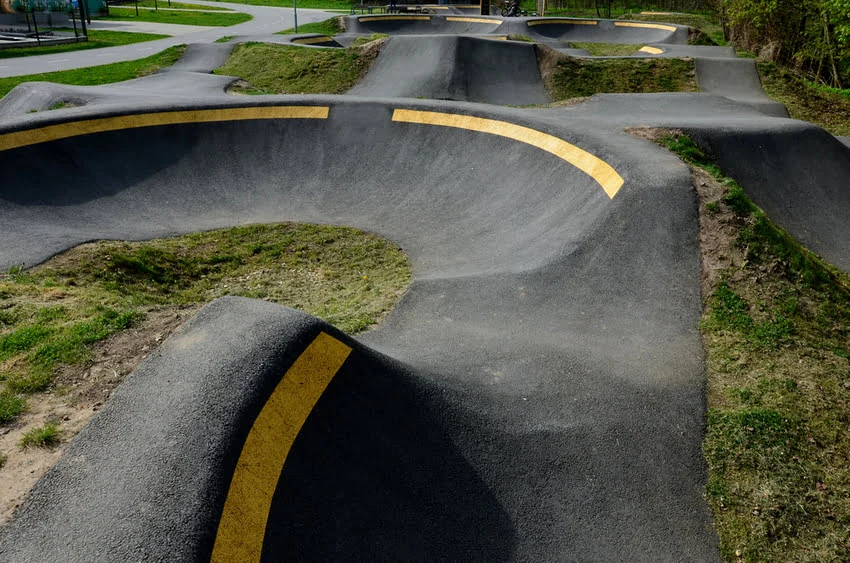
Riding a pump track is not only incredibly fun but also a great way to improve your control, stability, and comfort on two wheels.
So, what is a pump track exactly?
In short, a pump track is a continuous loop featuring berms (raised angled turns), rollers, and various obstacles that can be ridden on a bike without the need for pedaling. Instead, riders generate momentum through up-and-down body movements known as pumping. Hence the name.
Due to the way they are built, pump tracks are suitable for all skill levels, including complete beginners and seasoned pros. It’s up to you to decide what lines you want to take, how hard you want to take them, and how challenging you want your pumping session to be.
Keep reading to learn how to get the most out of your next pump track ride.
Benefits of Riding a Pump Track
Apart from being fun, what is the use of a pump track? The jumps and rollers look mild, and you don’t even need to pedal.
However, what many don’t realize is that the skills you acquire here also translate to mountain biking trails and cycling in general.
All of the berms, rollers, and jumps are always the same, which is great because it allows you to practice different approaches in predictable conditions. This way, you can focus on your skills without worrying about other factors.
By riding a pump track, you can build mountain biking skills like cornering, weight distribution, jumping, and the overall bike handling. All of these are very important on trails in the real world.
Next time when you encounter a berm or a roller on a mountain bike trail, it will feel familiar to you, and you’ll likely be able to take a much better line than before. Because you’ve already done it over and over again.
Pump Track Riding Essentials: Bike and Gear
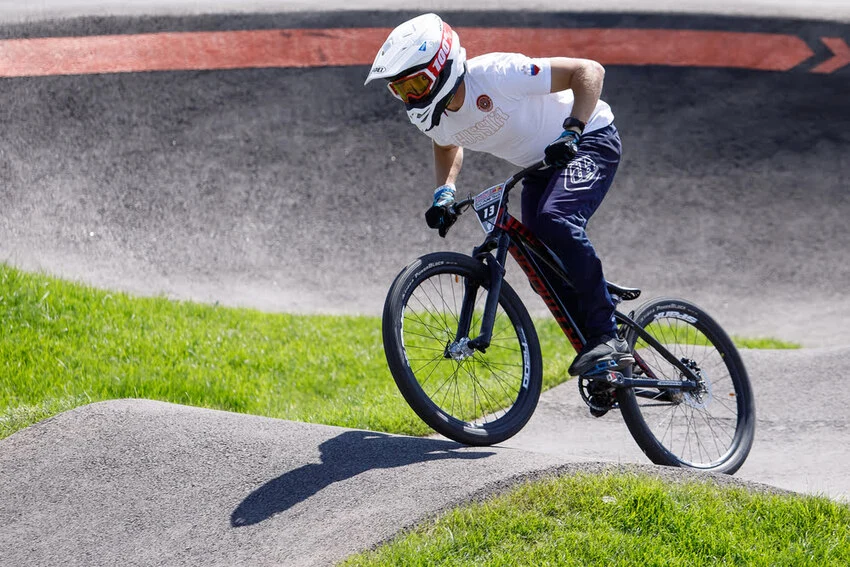
To get the most out of a pump track, it’s best to ride it on a BMX or a dirt jump bike. Also, make sure to always wear a helmet!
What I love the most about riding a pump track is that you need very little to get started.
In fact, all you need is a bike, and what’s even better is that you can use any bike you own.
The number one choice for most riders is to use a dirt jump bike or a BMX bike, but different types of mountain bikes are also common, and you can sometimes even spot riders on a road, gravel, or a hybrid. In addition to bikes, pump tracks can also be ridden on skateboards and scooters.
When it comes to gear, we recommend always wearing a bike helmet, because falls on a pump track can be dangerous, even though they are uncommon and typically mild.
If you’re trying out new things, like doing bigger jumps or riding at higher speeds, we recommend wearing a full-face helmet just in case, especially if you’re riding on a tarmac track.
Finally, wearing elbow and knee protectors is optional, but a good idea if you’re new to pump tracks and you want to avoid getting annoying scrapes. The same goes for wearing long-sleeved clothes, such as jeans and a hoodie.
Who Can Ride a Pump Track?
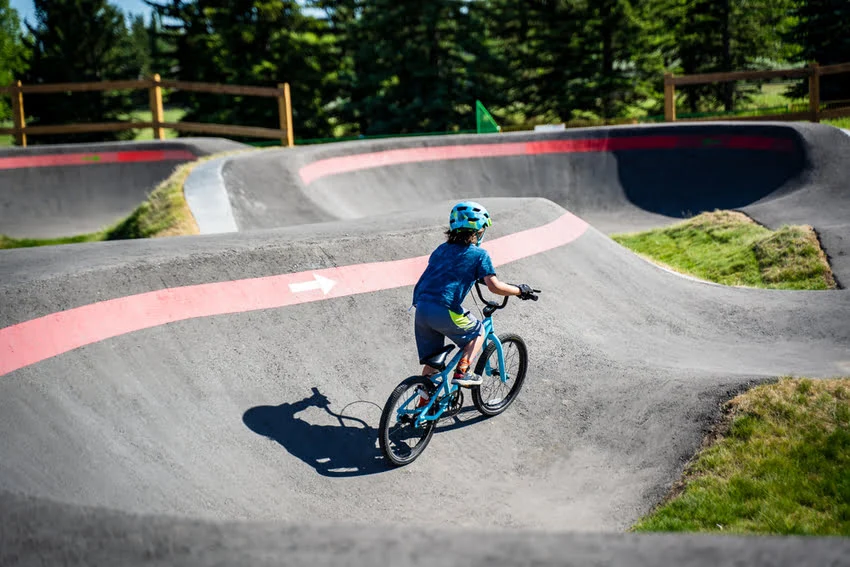
Pump tracks are usually perfectly safe for all riders, including children.
One of the best things you’ll notice when visiting a pump track is people of all ages and skill levels having fun and practicing.
These courses are designed in such a way that anyone can ride them. Kids on balance bikes and kids’ pedal bikes are common visitors on shorter loop courses which they share with adults on dirt jump and mountain bikes.
So, if you’re wondering if you’re too young or too old to go to your local pump track, I can confidently say that you are not.
Similarly, you’re probably also not under-skilled or over-skilled to ride one, as pump tracks cater to a wide range of abilities.
Key Pump Track Features
Pump tracks are usually designed as a loop or as a free flow course that consists of berms, rollers, jumps, and other similar features.
Here are short explanations of the most popular features and their uses:
- Rollers: Rollers are the fundamental part of any pump track. This is a sequence of small humps that you can use to gain momentum by pumping (pulling on the up part and pushing on the down part). They will help you develop balance and perfect your pumping technique.
- Berms: These are banked turns added to corners that allow you to turn while maintaining your momentum. They are another essential feature, ensuring the flow of the track. Berms are also common on mountain bike trails, so a pump track is a good place to practice how to ride them safely.
- Tabletop Jumps: These are flat-topped jumps that are perfect for beginners to practice jumping and landing safely. They let you bail on a jump if you decide to do so for any reason.
- Transfer Lines: As their name implies, these are sections that allow riders to transfer from one line to another, offering flexibility and adding variety to the track. They are most common on free form pump tracks.
Main Pump Track Types
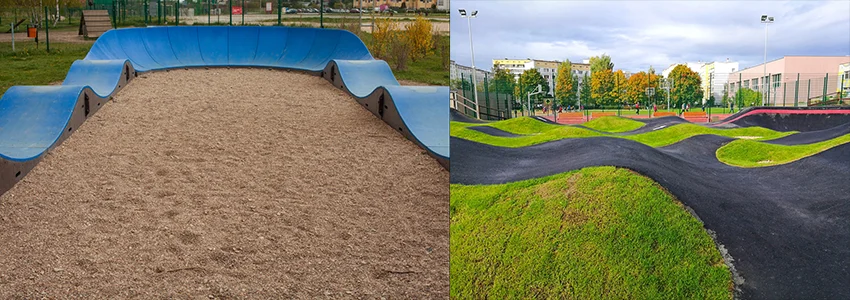
Loop vs. free flow pump tracks compared.
Pump tracks usually come in two main types—loop and free form.
Though similar, they offer some key differences in terms of riding styles and variations you can take when choosing lines.
- Loop Pump Tracks: This type of pump tracks is inspired by BMX tracks. It features a starting point and a finishing point, with a set of features in between that go into a loop. Loop pump tracks are great for beginners because they are predictable, and they are also popular among the skateboarding folks.
- Free Form Pump Tracks: These layouts also have a circular design, but the remaining sections in-between are also rideable and filled with features. This makes them similar to the layout of skateparks. Due to this approach, free form tracks offer countless directions and lines, making them more fun and more suitable for all skill levels.
Popular Pump Track Surfaces
The most common material pump tracks are made of is definitely dirt. The reason is simple—dirt is cheap, readily available, and it’s easy to make changes and add features in the future.
Tarmac pump tracks are also quite popular and have many benefits over dirt tracks. However, they are more expensive to build.
Dirt pump tracks are a lot more forgiving if you fall, but they require regular maintenance. Compacted dirt becomes loose over time, so regular time and effort is required to keep these tracks in mint condition.
Moreover, dirt tracks shouldn’t be ridden in very dry and very wet conditions, as this will accelerate their deterioration. Instead, it’s advisable to dampen the track if it’s very dry or wait for it to dry if it’s too damp.
What Bikes Are Best for Pump Tracks?
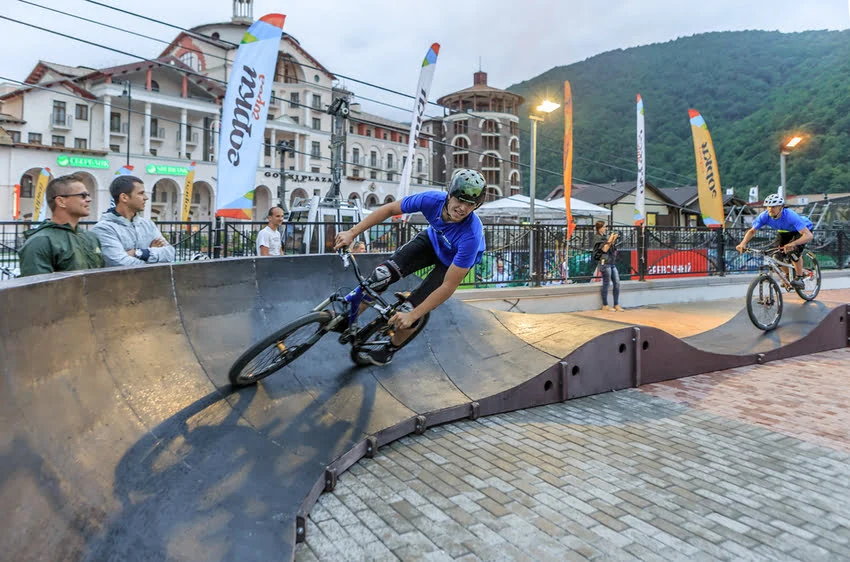
You can use any bike to ride on a pump track, but BMX, dirt jump, and mountain bikes are best suited.
When it comes to choosing the best bikes for pump tracks, BMX bikes and dirt jump bikes are the top picks.
These bikes are built for agility, with sturdy frames and responsive handling that make them perfect for navigating the tight turns, rollers, and jumps found on a pump track.
Mountain bikes, particularly hardtails, are also a great option, offering more versatility if you plan to ride both pump tracks and trails.
While you might see some riders on road, gravel, or hybrid bikes, these aren’t as well-suited due to their less rugged design.
In short, the best bike for a pump track is one that allows you to feel in control and confident, maximizing your fun and skill development.
Frequently Asked Questions
Can you pedal on a pump track?
Yes, you can pedal on a pump track, but you don’t need to. If you use the rollers and berms correctly, you’ll be able to gain speed and maintain momentum without pedaling, using the pumping motion. This is the main benefit of pump tracks.
What to wear to a pump track?
You can wear anything to a pump track, including casual clothes and bike-specific clothes. If you want to avoid scrapes, we recommend wearing thick jeans and a long-sleeved shirt. Otherwise, a pair of shorts and a t-shirt will suffice.
Do you need a special bike for a pump track?
No, you do not need a special bike to ride a pump track. That said, some bike types, such as BMX, dirt jump, and mountain bikes are better than other for this application. Some people also ride pump tracks on road, gravel, and hybrid bikes, but this is less common.
How long is a pump track usually?
Most pump tracks cover an area of around 10,000 square feet, which is an oval around 65 feet wide and 165 feet long. However, there’s no predetermined size requirement when building a pump track. Homemade backyard courses can be much smaller and still fun to ride.
Are pump tracks safe?
Yes, pump tracks are perfectly safe to use for riders of all ages and skill levels. Of course, collisions and falls can happen, so it’s important to take common precautions, such as wearing a helmet. Kids shouldn’t ride them without parents’ supervision, but everyone else can go wild.

